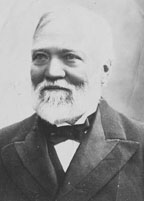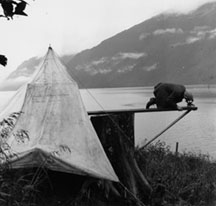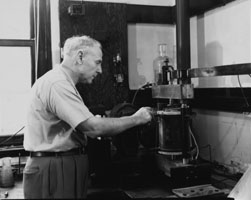A creation of Harry Wood and John Anderson, the device was patented by the Carnegie Institution of Washington in 1925 and was soon a fixture in earthquake-prone areas. Wood, knowing about the devastation of the earlier 1906 San Francisco quake, had convinced the Carnegie Institution to fund seismic research. The result was the Institution’s Seismology Advisory Committee, of which Wood became the manager. While at the committee’s helm, Wood also worked with Charles Richter, creator of the Richter earthquake magnitude scale, to set up one of the first seismograph arrays in a “shaken area.”
 Visitors can now
see a 1925 Wood-Anderson seismograph and a seismogram from the Long Beach quake
— along with a variety of other famous geoscience artifacts — at the Carnegie
Institution of Washington’s 100th anniversary exhibition. The Carnegie Institution
was home to such influential earth scientists as Norman L. Bowen, one of the
founders of modern petrology, and Louis Agricola Bauer, who pioneered the modern
mapping of Earth’s magnetic field. To celebrate its centennial, Carnegie is
opening its doors to the public to present artifacts from a long history of
scientific discoveries.
Visitors can now
see a 1925 Wood-Anderson seismograph and a seismogram from the Long Beach quake
— along with a variety of other famous geoscience artifacts — at the Carnegie
Institution of Washington’s 100th anniversary exhibition. The Carnegie Institution
was home to such influential earth scientists as Norman L. Bowen, one of the
founders of modern petrology, and Louis Agricola Bauer, who pioneered the modern
mapping of Earth’s magnetic field. To celebrate its centennial, Carnegie is
opening its doors to the public to present artifacts from a long history of
scientific discoveries. Andrew Carnegie (1865-1919), from the Hazen Collection
“We decided it was a great opportunity to bring people into our building,” says curator Margaret Hazen of the centennial exhibition, which occupies most of the second floor of Carnegie’s Washington, D.C., headquarters. Called “Our Expanding Universe: Celebrating a Century of Carnegie Science,” the exhibition will run until May 31 and is as expansive and informative as exhibitions at national museums elsewhere in Washington.
As part of the charitable contributions made late in his life, steel magnate Andrew Carnegie founded the Carnegie Institution of Washington in 1902 as a place for researchers to have both the freedom to confront fundamental scientific questions and the resources to pursue potential answers. The Institution is now a venue for both research and education, incorporating a Geophysical Laboratory; its Departments of Terrestrial Magnetism, Biology and Embryology; astronomical observatories; and the educational outreach programs First Light and the Carnegie Academy for Science Education.
 The exhibit
is housed in Carnegie’s main building in the DuPont Circle area of downtown
Washington. Made of Indiana limestone, the building was the creation of
John Mervin Carrere and Thomas Hastings, the same architects who designed the
New York Public Library and the Russell Senate Office Building.
The exhibit
is housed in Carnegie’s main building in the DuPont Circle area of downtown
Washington. Made of Indiana limestone, the building was the creation of
John Mervin Carrere and Thomas Hastings, the same architects who designed the
New York Public Library and the Russell Senate Office Building. From the entrance, the visitor enters the Board Room, a dark wood hall with an imposing limestone fireplace. Portraits of several Carnegie presidents hang on the walls. Also showcased are artifacts from the Carnegie Institution’s most influential associates — from a fossil femur to Andrew Carnegie’s walking stick made of rhinoceros hide.
An observer, probably L.A. Bauer, takes measurements of unusual magnetic disturbances at Treadwell Point, Alaska, in 1907. Courtesy of Carnegie Institution of Washington
Important letters, some penned by Carnegie, and facsimiles of letters from Franklin Roosevelt and Vannevar Bush. Bush was president of the Institution from 1939 through 1955. During his tenure, Bush directed the U.S. World War II science efforts for Roosevelt, including the Manhattan Project.
The main exhibition hall displays artifacts in a somewhat chronologic order, presented amidst striking display cases and music reflecting the periods of scientific study. One of the first displays visitors encounter is a scale model of the Carnegie, a ship commissioned in 1908 with minimal magnetic materials — totaling only 600 pounds — so that researchers on board could study Earth’s magnetic field as they traveled across the globe.
At the turn of the 20th century, magnetism was little understood despite centuries of observation. Louis Agricola Bauer, the first chief of the Department of Terrestrial Magnetism at the U.S. Coast and Geodetic Survey, wanted to map the Earth’s magnetic field. However, he was restricted by his government agency’s limited resources and inability to operate on a global scale. He submitted his plan for a Department of Terrestrial Magnetism to the Carnegie Institution in 1904, and he soon left federal employment to head the new effort.
Under Bauer’s leadership, Carnegie explorers embarked upon the most comprehensive geomagnetic survey of the time, ultimately collecting more than 6,000 magnetic measurements from the Pacific Ocean to Antarctica. The explorations were often dangerous: the teams were attacked by bandits and several men were lost to the sea. Our Expanding Universe includes several artifacts from the travels, including a logbook entry from a day when a crew member was lost overboard, and an early wood and metal chronometer from the ship.
In an inconspicuous location, amongst other artifacts of laboratory science, sits an
 artifact
that is far greater than its simple appearance: an old petrologic microscope
that belonged to Norman L. Bowen. The first Postdoctoral Fellow of the Institution’s
Geophysical Laboratory, Bowen conducted research at Carnegie from 1912 to 1937.
His work, including the groundbreaking book The Evolution of the Igneous Rocks,
revolutionized experimental petrology and our understanding of mineral crystallization.
Beginning geology students are familiar with his his “reaction series” depicting
how different minerals crystallize under varying pressures and temperatures.
artifact
that is far greater than its simple appearance: an old petrologic microscope
that belonged to Norman L. Bowen. The first Postdoctoral Fellow of the Institution’s
Geophysical Laboratory, Bowen conducted research at Carnegie from 1912 to 1937.
His work, including the groundbreaking book The Evolution of the Igneous Rocks,
revolutionized experimental petrology and our understanding of mineral crystallization.
Beginning geology students are familiar with his his “reaction series” depicting
how different minerals crystallize under varying pressures and temperatures.
Norman Bowen working at the Geophysical Laboratory. Courtesy of Carnegie Institution of Washington
In all, the exhibition features more than 130 artifacts displaying accomplishments not only in geoscience, but also in astronomy, biology and archaeology. One display is devoted to the research of Edwin Hubble and includes his eyepiece from the Institution’s 100-inch Hooker telescope, the largest of its day. It was with that scope that Hubble recognized that we live inside one of millions of galaxies within an expanding universe. Also within the exhibit case is one of the key photographic plates that led him to his discoveries.
Our Expanding Universe not only reveals how the Carnegie Institution has helped to shape science discoveries, but it also brings the visitor close to actual artifacts from these achievements. A trip to the exhibition is a worthwhile experience for the curious visitor.

